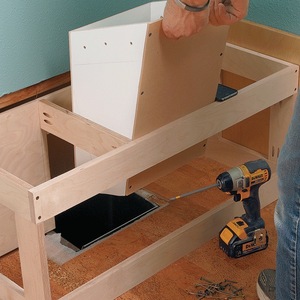Greetings all –
Since electrical ranks right at the bottom of my list of trades where I have any knowledge whatsoever, I’m looking for opinions…
Considering purchase of a 1952 vintage rancher , 1400 sq. ft., for remodel and resale. Good structure, floor plan, lot, neighborhood, etc. Wiring is all two-wire with no ground. New 100 amp panel set, but all original wiring led to/from it. So I’m assuming this is an open ground condition at all outlets, right? Aside from the fact that you can’t plug in a modern device (without changing out the receptacle, anyway), is this just an inconvenient, oudated system, or is it dangerous?
Since I can handle about everything but electrical, I’ll have to sub it out, which I’m willing to do. The electrical plan isn’t extensive or complex, so I’m figuring the cost should at least be reasonable, which I can absorb, given the low price I’m about to get the house for.
Thanks in advance for any thoughts ….
Bruce
Between the mountains and the desert …


















Replies
I wouldn't let the electrical scare you off.
A ranch is easy to upgrade electrical since there is access to either the top or bottom of every wall to run new romex.
Just because it's two wire doesn't neccessarily mean there isn't a good ground through the conduit, although that's probably questionable. It could just be a matter of adding new recepticles and a ground wire to the box.
I'd highly recommend using an electrican that is used to working on remodels since some who work primarily on new construction don't have much experience fishing wires and waste a lot of time. One group of electricans didn't even own a fish tape (!) and they had to borrow mine each time a wire was fed through an exsisting wall.
You also may get lucky and find someone who will let you do some of the dirty work if you're interested in saving money. Fishing wire takes time and isn't the most fun. The electrican I work with lets me run the wire, cut in new outlets, and he makes the connections and checks the routing for any problems--win/win.
Basically it's drilling a hole in the top/bottom plate, running the fish tape to the new box, attaching the romex to the fish tape and pulling it through. No rocket science, but if you go this route have him explain what you need to do for routing the wire. Some situations require certain stapling or supporting procedures.
Good luck,
Don
Beer was created so carpenters wouldn't rule the world.
doesn't neccessarily mean there isn't a good ground through the conduit
Conduit?? Don't have no stinking conduit...all the old style, pre-plastic covered Romex. How does that affect the situation.
there is access to either the top or bottom of every wall
You can get into the crawl space on your belly or your back, but ya can't roll over once you're there...that gives you an idea about the access to the bottom plate. Right now, all electrical is fed from the attic. I'm not a fan of crawling through blown cellulose, but at least I don't have to slide on my belly up there.
Thanks for the tips, though ...Bruce
Between the mountains and the desert ...
Conduit?? Don't have no stinking conduit...all the old style, pre-plastic covered Romex. How does that affect the situation.
You may be able to simply add a separate ground wire if everything else is in good condition.
Beer was created so carpenters wouldn't rule the world.
That wire may well have a ground in it. Many times they wound it around the cable right where it clamped to the box.
If your lucky
That should be easy to check at the panel. Last one I worked on had ground coming out of bath. It had been broken out with j-box in crawl and had gone to copper water pipe that had been there before but replaced.
Bruce, you say " I'm not a fan of crawling through blown cellulose, but at least I don't have to slide on my belly up there."I would much rather crawl through blown cellulose than blown fiberglass!!!! Cellulose does not make me itch. Just wear a particulate mask. Double straps better than single straps for the throwaway models.Frank DuVal You can never make something foolproof because fools are so ingenious.
"Aside from the fact that you can't plug in a modern device (without changing out the receptacle, anyway"
What modern device?
Check around and you will find very few devices, outside of tools, that have grounded plugs on them.
You can legally replace the 2 prong recptacles with 3 prong GFCI's or 3 proong receptacles that are protected up upstream GFCI's. But they are suppose to be labeled as No Equipment Ground.
This does give the same personal safety as grounded receptables. And you you should update then for the kitchen countertop and bathroom anyway.
But you probably need to bring some new circuits for those areas anyway and they would of course be grounded.
Two areas where trued grounded receptacle are important.
1. Anyplace that the false trip of the GFCI would cause problems. This include refigerators, freezers, and sump pumps. And refigerators are know to trip GFCI's.
The other is for surge protectors. To get maximum protection against surges they need a true ground.
I would concentrate on the kitchen and bathroom electrical as they probably need to be updated anyway. You probably will need circuits for microwave and DW requirments. And the current bath circuit is probably shared by 1/2 the house.
It's safe. Before aluminum and back-stab outlets.
Things you need to do:
1) Have someone install GFCI outlets in bathrooms and near sink. (If bathrooms have only the "convenience" outlet on the light fixture, consider paying the sparky to install a regular outlet.) Also, GFCIs should be installed for any outdoor outlets.
2) Get a new, properly grounded outlet (or two) installed for your main computer location. This will be needed to make surge protectors effective.
3) Check all overhead lights to make sure that oversized bulbs aren't installed. If they are (or were) the wiring is probably cooked up there (maybe even if oversized bulbs weren't installed). You may need to have your sparky replace the last few feet of wire for some fixtures, installing a junction box in the attic.
As someone said, this vintage wiring MAY have ground wires in the boxes (though probably not). If there are ground wires, and they are properly connected everywhere (not a given) then you can install 3-prong outlets. Checking the ground wires requires someone who knows what they're doing.
happy?
"It's safe. Before aluminum and back-stab outlets."A friend of mine has an 1955 house and it has backstab receptacles.And they take #12. And they don't have any screw terminals either.
Bill
Maybe you or DanH would know this, and it has nothing to do with the thread, but when(approx) did they start putting grounded outlets in and when did alum wire happen?
Just currious
doug
I know that a house my parents had remodeled ca 1965 had grounded outlets, and the requirement was pretty new then. AL wiring dated from about the same time. But re the grounded outlets, a lot depends on local code and "customary practices". Probably some homes were built with them about 1960, and likely code didn't require it in all parts of the country until 1970. But I know that some homes built prior to 1960 had grounded romex in them.Re AL wire, I can remember that there was a copper shortage in the mid-late 60s that pushed things along. AL may have been available and legal before that but wasn't used to any degree until that shortage.
If ignorance is bliss why aren't more people
happy?
Thanks Dan
Did it have full size grounds?For a short period of time they sued #16 for the ground (at least on #14 NM).I found one run in some of the modifications that where done on the 55 house.
Did it have full size grounds?
Isn't that fun to find? Stiff, old, solid conductors, and a flimsy, feels-like-a-twist-tie grounds . . .
And, they are never, but never, made up with wire nuts, the receptical (switch, outlet, whatever) has everything bound up under a run out-to-almost-not-in-the-fixture screw . . .
<sigh> Luckily, I'm no longer legally able to have that much fun--has to be a JM (& helper) now . . . Occupational hazard of my occupation not being around (sorry Bubba)